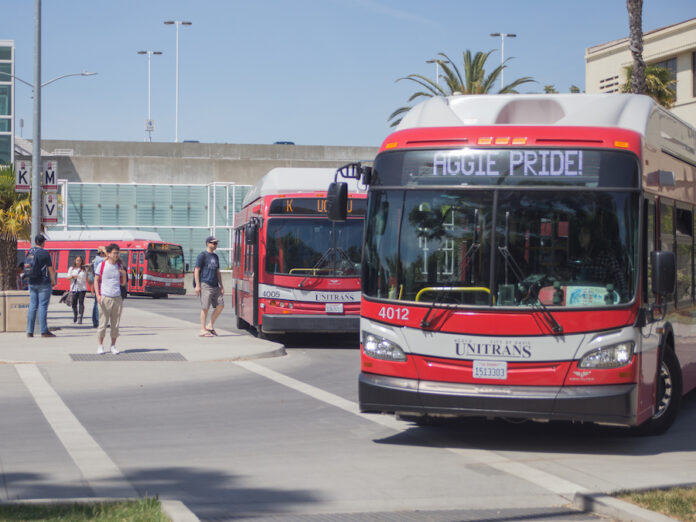Unitrans drivers speak on what they love about their jobs
The Unitrans buses driven by undergraduate students are a distinctive campus feature and are described to prospective students as such, but to UC Davis students, seeing the distinctive red buses soon becomes a regularity. According to Bob Black, ASUCD President from 1966 to 1967, the first time a bus ran was on Feb. 28, 1968 during a time of war. Students wanted to show “how [they] could build stuff and run things” because they, “the draftees, wanted a say, wanted a voice and wanted the vote.” 51 years later, Unitrans carries over 20,000 riders a day, from first-year students wanting to go to Target to older students heading back to their apartments after the day’s classes.
Unitrans is managed by ASUCD and hires new employees once or twice a quarter. Weston Snyder, a third-year history and international relations double major and the Unitrans operations manager and route supervisor commuted to school his first year, and having his car meant that he didn’t need to take the bus.
“I really wanted to drive the double decker bus,” Snyder said. “I saw them driving around campus all the time, driving around the city. I didn’t really know anything about Unitrans […] but I just knew I wanted to drive, so I applied for a job and ended up getting it.”
He applied for the job in January 2017 and, after being accepted, had to undergo training. Employees have a background check and a pre-employment drug screening before they start additional training. Since a Class C license — what most drivers need to drive a car — is not sufficient to drive a Unitrans bus, training starts with drivers going through a classroom-like tutorial to prepare them for the Class B permit test.
According to third-year wildlife, fish and conservation major Mario Mayo, having a Class B license is primarily about the technical features of the vehicle. There are other factors to be aware of, however.
“Based on what other drivers have said and things that I’ve looked up, [Class B drivers] do get penalized more […] if we’re pulled over,” Mayo said. “Even if we’re driving our own vehicle and they see that we have a Class B [license], there could be a larger fine or whatever it may be. That’s something to know […] since we have a Class B, they assume that we’re more responsible and that we should be driving a little bit safer.”
After passing the permit test, there is phase training, which consists of 15 phases in which drivers work with experienced student drivers. Then, they take the three-part DMV test in a Unitrans bus, which includes a pre-trip inspection of the vehicle, a skills test and a road test. After obtaining the Class B license, employees become route trainees, who are taught Unitrans policies, the routes themselves and how to drive safely and operate a vehicle with passengers in it. Getting the license itself doesn’t require passengers to be in the vehicle. For Mayo, it took about two and a half months before he became a solo driver.
Unitrans drivers take shifts in order of seniority, and all shifts are decided prior to the start of the quarter. Each driver has to take a few weekend shifts and take some early morning or late night shifts.
Snyder also said that passengers aren’t necessarily aware of everything the drivers have to focus on, including animals and, particularly during winter quarter, the weather.
“Unitrans management tells us that passenger safety is the number one priority,” said third-year geology major and Unitrans driver LeAnne Page. “Which is [why] buses often run late in the rain — because it’s sometimes necessary to drive slower in the rain.”
Page applied to be a Unitrans driver because it paid more than working at the Coffee House and because she loved driving. She described driving a bus as “the coolest thing possible.”
“If you need a job on campus, it’s definitely an option,” Mayo said. “We hire a lot […] and it’s like a good community, especially if you don’t feel like you have one on campus. It’s a good place to start for sure.”
When asked about their favorite part of being a Unitrans employees, both Snyder and Mayo said that it is definitely the community that they’ve formed with co-workers.
“It’s nice [that] we form that little community,” Mayo said. “All the drivers get together before the buses depart, and everyone’s just super nice and friendly, and they’re always willing to help you out. If you don’t know anything, there’s going to be someone to help you. […] I definitely have my closest friends at Unitrans, and it’s really nice that we can build friendships that way.”
Despite the fact that Unitrans buses are a key fixture at Davis, many students don’t know too much about what goes into it.
“I think a lot of people don’t recognize a lot of the work that gets done just to keep Unitrans running,” Snyder said. “Like, for instance, I’m a supervisor and five days a week. […] Supervisors come in at five in the morning and start getting the buses ready, getting all the paperwork ready for the day and then there’s still going to be someone there working, not the same person obviously, but there’s going to be someone working all the way past midnight that night.”
Written By: ANJINI VENUGOPAL — features@theaggie.org




